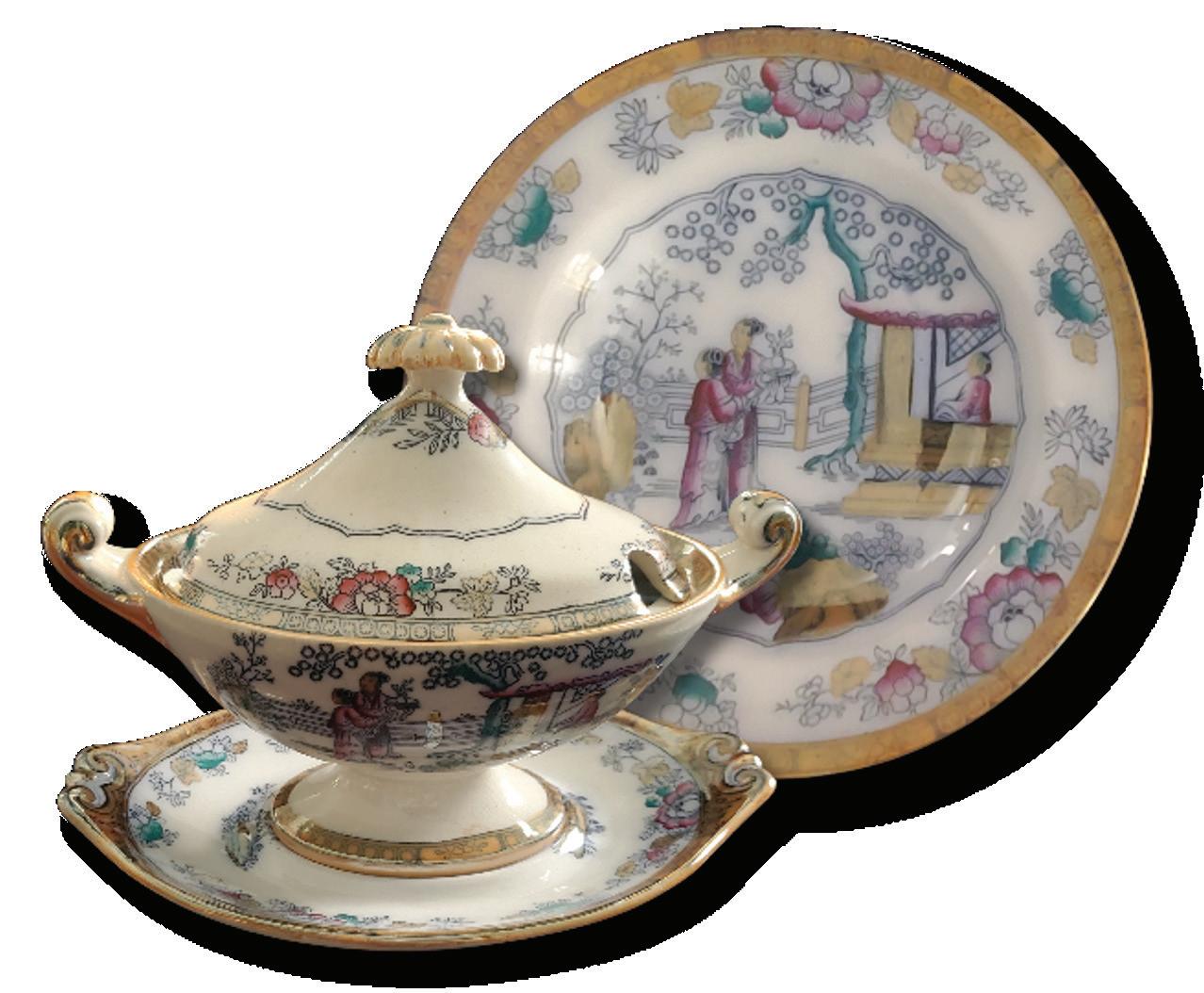Historically Speaking
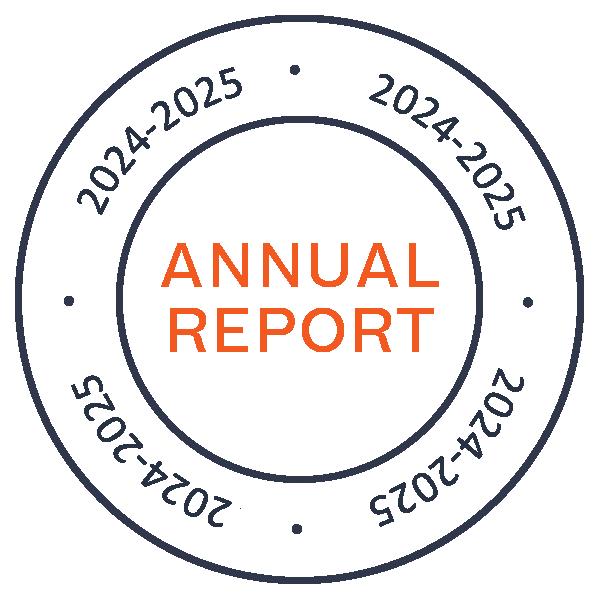








As we close out another remarkable fiscal year, I find myself reflecting not only on what Historic Columbia has accomplished, but also on what these achievements reveal about who we are—and who we’re becoming. FY25 was a year defined by progress, collaboration, and purpose. Across every department, our staff and volunteers embraced new ways to make history accessible, relevant, and alive for the people we serve.
From earning the Southeastern Museums Conference Gold Award for Heat & Hardship: The Hidden Labor of Enslaved Cooks to launching our first-ever digital guide on the Bloomberg Connects app, Historic Columbia continued to push boundaries while staying rooted in our mission. We engaged nearly 5,000 students through the Traveling Trunks program, offered record access to our gardens and free community events, and reimagined our Welcome Center as a true gateway to discovery. These successes are more than organizational milestones—they reflect the heart of what happens when dedicated people believe deeply in the power of place and story.

As part of our strategic planning this year, we were challenged to think 50 years ahead. What will Columbia look like in 2075, and how can Historic Columbia continue to serve a community that will undoubtedly be more diverse, more interconnected, and more shaped by technology than ever before? That question—how we prepare for the society of the future— has guided much of our reflection this year.
Our past offers perspective. It reminds us that preservation is never about holding still; it’s about evolving with intention. The same values that inspired our founders in 1961— stewardship, education, and civic pride—continue to anchor us today. But our methods, partnerships, and audiences continue to expand. We are broadening our definition of history to include more voices, more experiences, and more ways for people to engage. That is both our responsibility and our opportunity.
What gives me hope for the future is the spirit I see every day at Historic Columbia—the collaboration between staff and board, the creativity of our educators, the commitment of our volunteers, and the generosity of our supporters. Together, we are building an organization that is not only preserving Columbia’s heritage, but also shaping a more inclusive and inspired vision for the years to come.
Historic Columbia’s resolve for equity, access, and partnership will carry us forward. Grounded in reflection, guided by a vision for the future, and inspired by purpose, we will continue to evolve—strengthening the connection between past and present, and ensuring that the stories of this place remain accessible, meaningful, and alive for generations yet to come.
Warm regards,

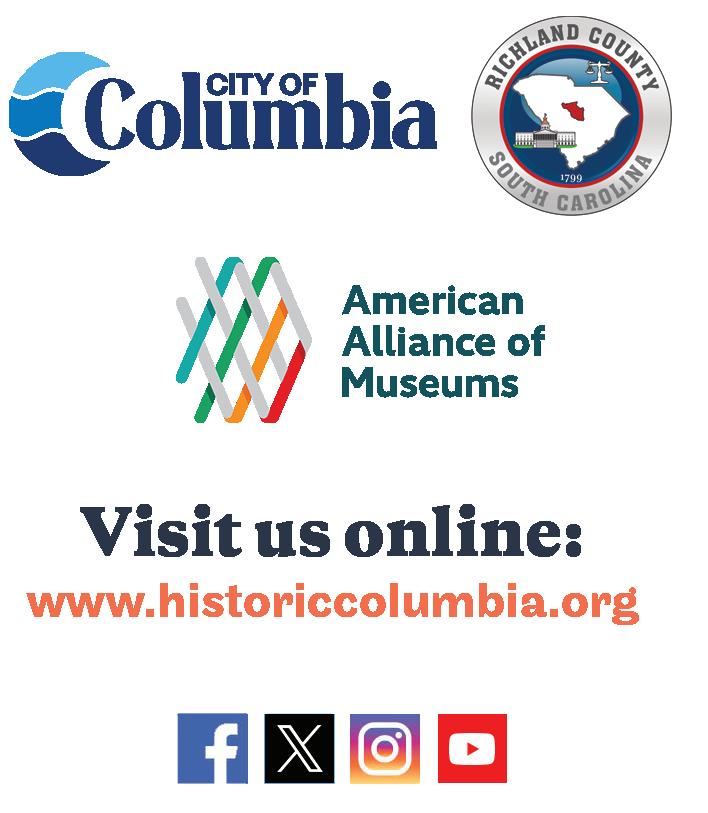
Board of Trustees
Rodrick Shiver, President
Carroll Heyward, 1st Vice President
Ty Patterson, 2nd Vice President
Alex Guzman, Treasurer
Donna Wages, Secretary
Ex-Officio Members
Gretchen Barron, Richland County Liaison
Aditi Bussells, Columbia City Council Liaison
Lauren Elliott, HCAC Chair
Ari Robbins, Palladium Chair
Lauren Elliott, Chair
Jim Byrum
David Bornemann
Ann Cameron
Patrick Cleary
Beryl Dakers
Jessica I. Elfbein
Monya Havekost
Kathy Hogan
Ann Holtschlag
At-Large Members
Debbie Douglas
Mary Elam
Lura Folline
Cory Manning
Andrew Rogerson
Todd Shaw
Gwen Thurmond
Julie Tuttle
Michelle Hurley-Johnson
Olivia Hyatt
Gloria S. James
Brian Johnston
Jamie Keller
Richard Linden
Andrew R. Lucas
Betsy McDonald
Katharine Allen, Director of Education & Interpretation
Jake Armstrong, Horticulture Assistant
Heather Bacon-Rogers, Visitor Experience Manager
Catherine Beltran, Marketing & Communications Manager
Suzanne Brooks, Executive Director
Emily Brown, Director of Marketing & Communications
Nathan Brown, Office Manager & Executive Assistant
Autumn Chandler, Collections Manager
Walter Chavis, Landscape Technician
Carl Cox, Rentals Coordinator
Katherine Crawford, Development Coordinator
Scotty Faltynski, Rentals Office Assistant
Todd Miller
Stuart Moore
Jeff Payne
C.D. Rhodes
Henry Roe Cleve Walker
J. Calhoun Watson
Aaron West
Toni Wilson
Brooke Flory, Program & Communications Coordinator
Debbie Giles, Business Manager
Joe Glenn, Facilities Assistant
Li Hubbard, Weekend Staff Coordinator
Kevin Jennings, Director of Buildings
Beth Johnson, Education Assistant
Chris Mathis, Horticulture Manager
Adam Miller, Group Tour Coordinator
Carmen Sangster, Education Manager
John Sherrer, Director of Preservation
Rebecca Townsend, Curator of Living Collections
David Turner, Director of Advancement
Rebecca Woodruff, Curator of History
Ari Robbins, President
Russell Cox, President-elect
Chandler Garnett, Secretary
Kyle Alston
Bellinger Boylston
Brandon Buchanan
Janie Campbell
Michael Caraballo
Eric Meadows
Matthew Morrison
BJ Phillips
Christy Steiger
Nell Warthen
Alexandra Woodlief
Cory Wyckoff
Carman Young
Andrew Rogerson, Past President, ex-officio
In February 2025, Historic Columbia’s opened an exhibition titled Heat & Hardship: The Hidden Labor of Enslaved Cooks It has since received the Gold Award in the Southeastern Museums Conference (SEMC) Exhibition Competition for projects with budgets of $25,000 and under. This top honor recognizes exceptional achievement in design, content, and interpretation across museums and cultural institutions throughout the Southeast.
Located in the warming kitchen of the Robert Mills House, Heat & Hardship invites visitors to engage with a part of the site’s history that was long overlooked—the lives and labor of the enslaved people who worked in the home’s kitchen spaces. Using touch, sound, smell, and first-person narrative, the exhibition immerses visitors in the physical and emotional realities of daily life for enslaved cooks in early 19thcentury Columbia. The multisensory approach encourages empathy and understanding, transforming a historic structure into a deeply human storytelling space.
Funded by South Carolina Humanities, Heat & Hardship represents a major collaborative effort among Historic Columbia’s staff and community partners, with interpretation developed through rigorous research and consultation. It also exemplifies our
From earning a top Southeastern Museums Conference award to serving over 5,000 students through Traveling Trunks and setting recordbreaking plant sale revenue, FY25 was a year of achievement. These milestones highlight how Historic Columbia continues to educate, inspire, and grow with our community.
organization’s continued commitment to telling fuller, more inclusive histories— acknowledging not just architectural beauty, but the people whose forced labor sustained it.
The SEMC jury commended the exhibition for “stretching the limits of design and content,” noting its innovative use of a small space to create a powerful interpretive experience. For Historic Columbia, the award affirms years of investment in creative interpretation and community-centered storytelling. Heat & Hardship stands as a model for how museums can connect audiences to complex histories with honesty, sensitivity, and impact—

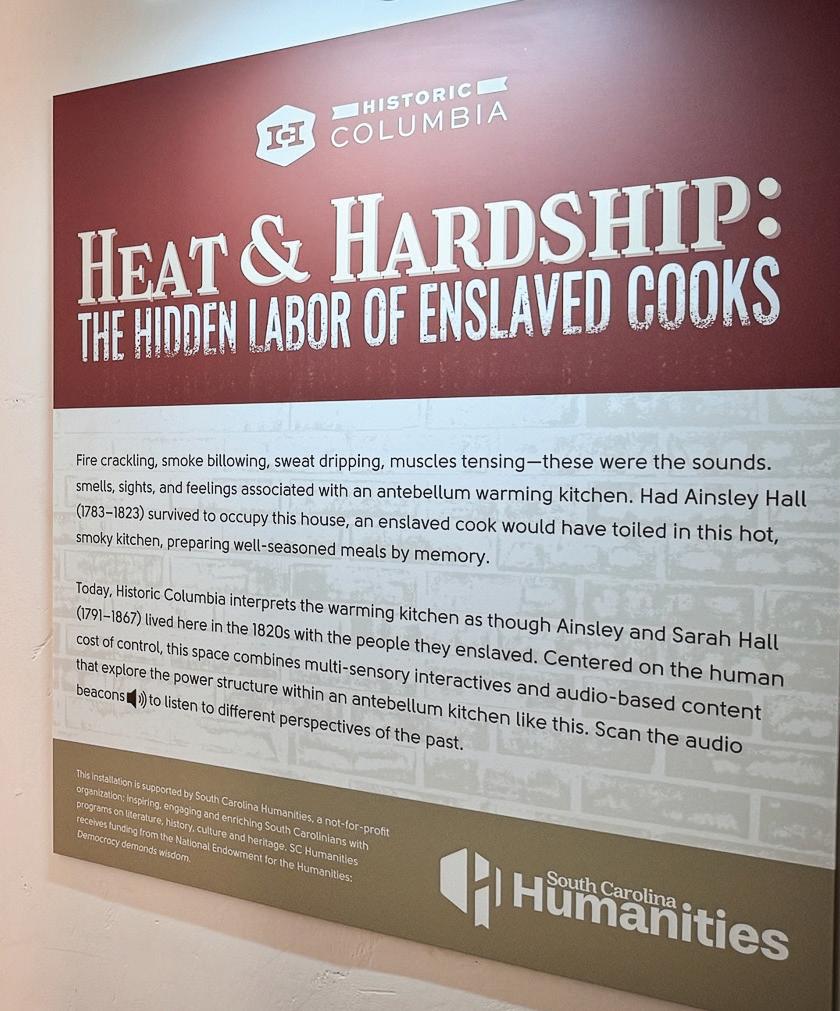


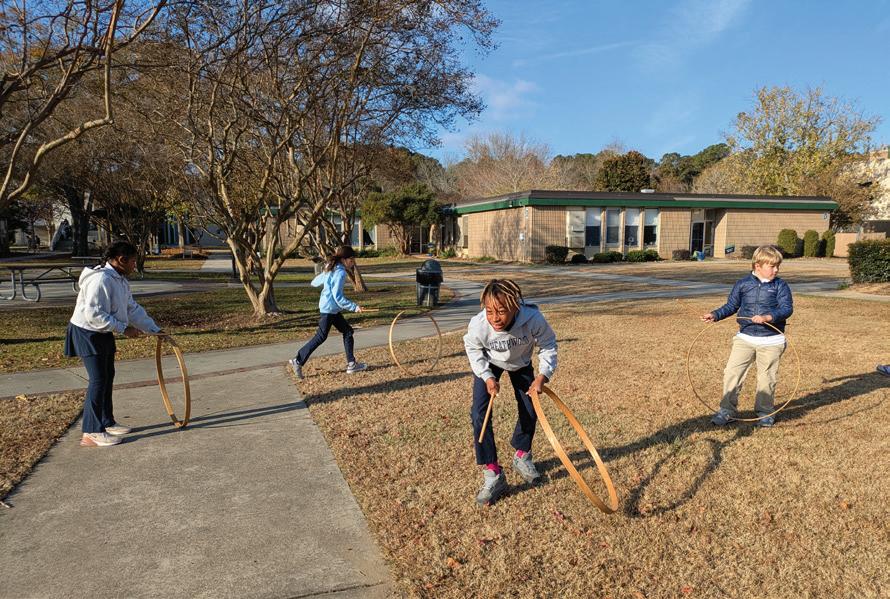
Education Assistant Beth Johnson engages students with artifacts and activities from Historic Columbia’s Traveling Trunks, making history come alive through hands-on learning.
n FY25, Historic Columbia’s Traveling Trunks program reached an unprecedented 5,126 students, the most in the program’s history. These trunks bring authentic artifacts, interactive activities, and standards-based lessons directly into classrooms, helping students connect local history to larger national themes.
This year also marked the debut of a new resource, the Slavery in the Antebellum Era trunk, which deepens HC’s ability to tell complex stories of the past. Alongside this addition, existing trunks like Mapping Columbia, Historic Games, and Reconstruction continued to inspire and educate students of all ages.
By combining interactive learning with real-world context, the Traveling Trunks program continues to grow as one of Historic Columbia’s most impactful educational offerings—bringing history alive for thousands of young learners across the state.
Historic Columbia’s beloved Plant Sale blossomed in a new way this spring with the introduction of an online pre-order system exclusively for members. This first-ever digital launch expanded accessibility, making it easier than ever for supporters to browse and purchase from the comfort of home.
Through this new platform, HC members ordered 252 plants, generating $3,105 in revenue—a strong show of support that demonstrated how deeply our community values both convenience and connection. The online sale allowed members to reserve their favorite plants in advance, guaranteeing access to popular varieties and streamlining on-site pick-up during the Spring Plant Sale weekend.
Beyond its fundraising success, the shift online was about strengthening engagement. Many members shared that the digital catalog made it easier to explore plant details, plan their purchases, and support Historic Columbia’s horticultural mission in a new way. The sale also underscored the dedication of our horticulture team and volunteers, who nurture and interpret the living collections across our properties.
By blending technology with tradition, the new online sale not only modernized a cherished event but also reaffirmed Historic Columbia’s commitment to accessibility and innovation—ensuring that every member can take a piece of our gardens home, no matter how they choose to shop.
Teachers praised the trunks for their hands-on nature and classroom impact:
Amazing presentation and hands-on activities for our students. The perfect balance of educational support then application of the lesson. We are excited for next year!”
— Historic Games Trunk
“
“Thank you so much for giving our students an awesome experience! The learning from the Traveling Trunk has definitely transferred into the classroom.”
—Mapping Columbia Trunk
“
“I appreciated how engaging and interesting it was! The children loved it and we learned so many new facts.”
— Reconstruction Trunk

At Historic Columbia, the past year has been one of both reflection and forward motion. Executive Director Suzanne Brooks marks her first year of leadership with a look back at the milestones that defined 2024–25, while new and evolving roles across our staff highlight the talent, creativity, and dedication that fuel our mission every day. Together, these stories show how HC continues to honor its history while building momentum for the future.
Q: Suzanne, you’ve just completed your first year leading Historic Columbia. How would you describe the experience?
Suzanne: Humbling and energizing. Coming into this role, I knew Historic Columbia was a strong organization, but seeing the staff and volunteers in action has been inspiring. Every day, I’m reminded that history isn’t static— it lives and breathes through the people who care for it and share it.
Q: What are you most proud of from this first year?
Suzanne: I’m most proud of the work we did together to develop the Bridge Plan. It gave us the space to pause, reflect, and chart a clear course forward while aligning our daily work with bigpicture goals. Having that shared strategy in place means we’re not just reacting—we’re moving intentionally toward the future of Historic Columbia.
Q: What surprised you most about Historic Columbia this first year?
Suzanne: Stepping into this role gave me a new appreciation for just how much happens behind the scenes to keep Historic Columbia thriving. The scope of what our team manages— from preservation projects to education programs, rentals, and partnerships—is incredible. Seeing how all those moving parts fit together to tell one cohesive story has been both eye-opening and inspiring.
Q: As you look ahead, where do you see Historic Columbia going?
Suzanne: We’ll continue balancing care for our historic sites with creating dynamic, relevant experiences for visitors. My focus is on deepening partnerships, broadening our audience, and making sure every Columbian feels welcome to see their story reflected here.

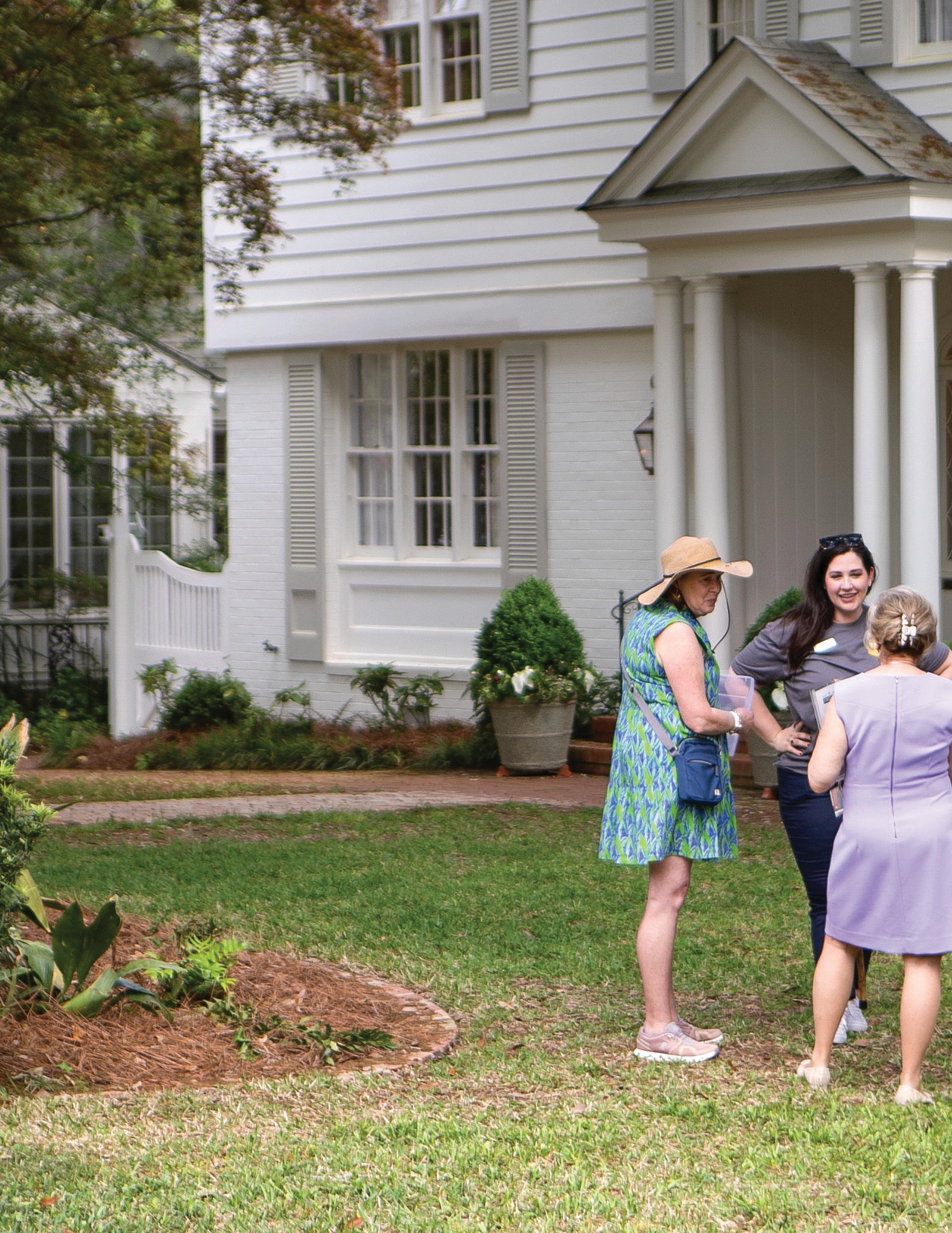
This past year brought exciting staffing changes across Historic Columbia, reflecting a commitment to collaboration, professional growth, and long-term impact.
• David Turner returned to Historic Columbia as Director of Advancement, aligning development and marketing to grow philanthropy opportunities.
• Kat Crawford joined as Development Coordinator, contributing a decade of nonprofit development experience, most recently at Palmetto Trail.
• Brooke Flory was hired as Program & Communications Coordinator, bringing event logistics and ticketing operations under the marketing umbrella for streamlined outreach.
• Rebecca Townsend was promoted to Curator of Living Collections, elevating HC’s gardens to museum-quality stewardship and expanding educational programming.
• Adam Miller was promoted to Group Tour Coordinator, expanding outreach to tour groups and cultural organizations.
• Li Hubbard was promoted to Weekend Staff Coordinator, overseeing operations and scheduling for weekend guides.
• Heather Bacon-Rogers was promoted to Visitor Experience Manager, overseeing site operations, staff leadership, budgets, scheduling, and driving revenue goals across house tours, and group sales.
• Autumn Chandler joined HC as Collections Manager, caring for the object collection and managing new accessions, bringing international training and experience in accessibility and women’s history.

It feels great to be back at HC, helping align our philanthropy efforts with the stories we’re telling.

Flory
Bringing programs and communications together makes it easier to connect people to HC’s events.

My goal is to bring more groups through our doors so even more people can experience Columbia’s history.

Heather Bacon-Rogers Visitor Experience Manager
Visitor experience is about more than tours—it’s about creating a welcoming campus where everyone feels at home.
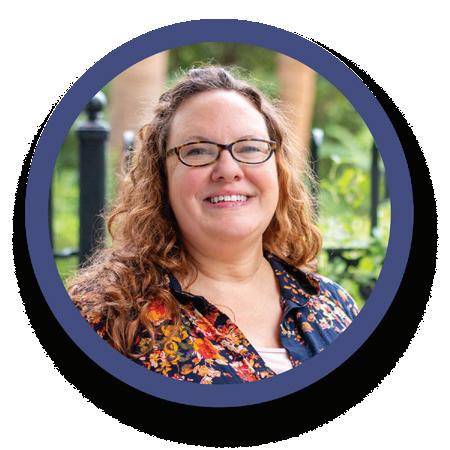
I’m excited to connect donors to the impact they’re making at HC every single day.
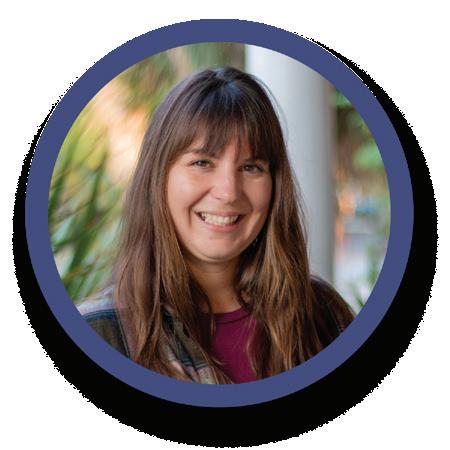
Our gardens aren’t just beautiful spaces — they’re living collections that tell history in their own way.
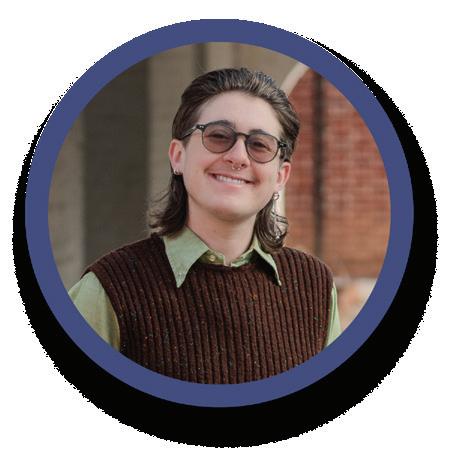
Li Hubbard Weekend Staff Coordinator
Weekends are when many visitors first meet HC. I’m proud to help our guides make that first impression count.

Autumn Chandler Collections Manager
I love caring for objects that hold so many stories and finding new ways to make them accessible.
As Historic Columbia looks to the future, we are embracing a pivotal year of transition and intention. Fiscal year 2026 will serve as a Strategic Bridge Plan—an essential moment of reflection, refinement, and readiness. With major capital projects underway, evolving technologies, and new leadership guiding our path, this one-year plan allows us to stabilize, assess, and strategically position our organization for bold, long-term goals beginning in FY27. Rather than rushing into a new multi-year strategy, we are using this bridge year to close knowledge gaps, test systems, and align staff and board functions. The plan centers on four core

priorities: strengthening organizational health, improving access, assessing stewardship of property, and creating a more welcoming campus. Through these focus areas, we aim to collect the data, experience, and insights that will shape a three-year plan grounded in sustainability, innovation, and impact. This graphic outlines the Strategic Bridge Plan in full, and invites you—our community of supporters, volunteers, and partners—to join us in laying the groundwork for the next era of Historic Columbia’s work. Together, we are ensuring our past continues to inspire a more connected, inclusive, and resilient future.
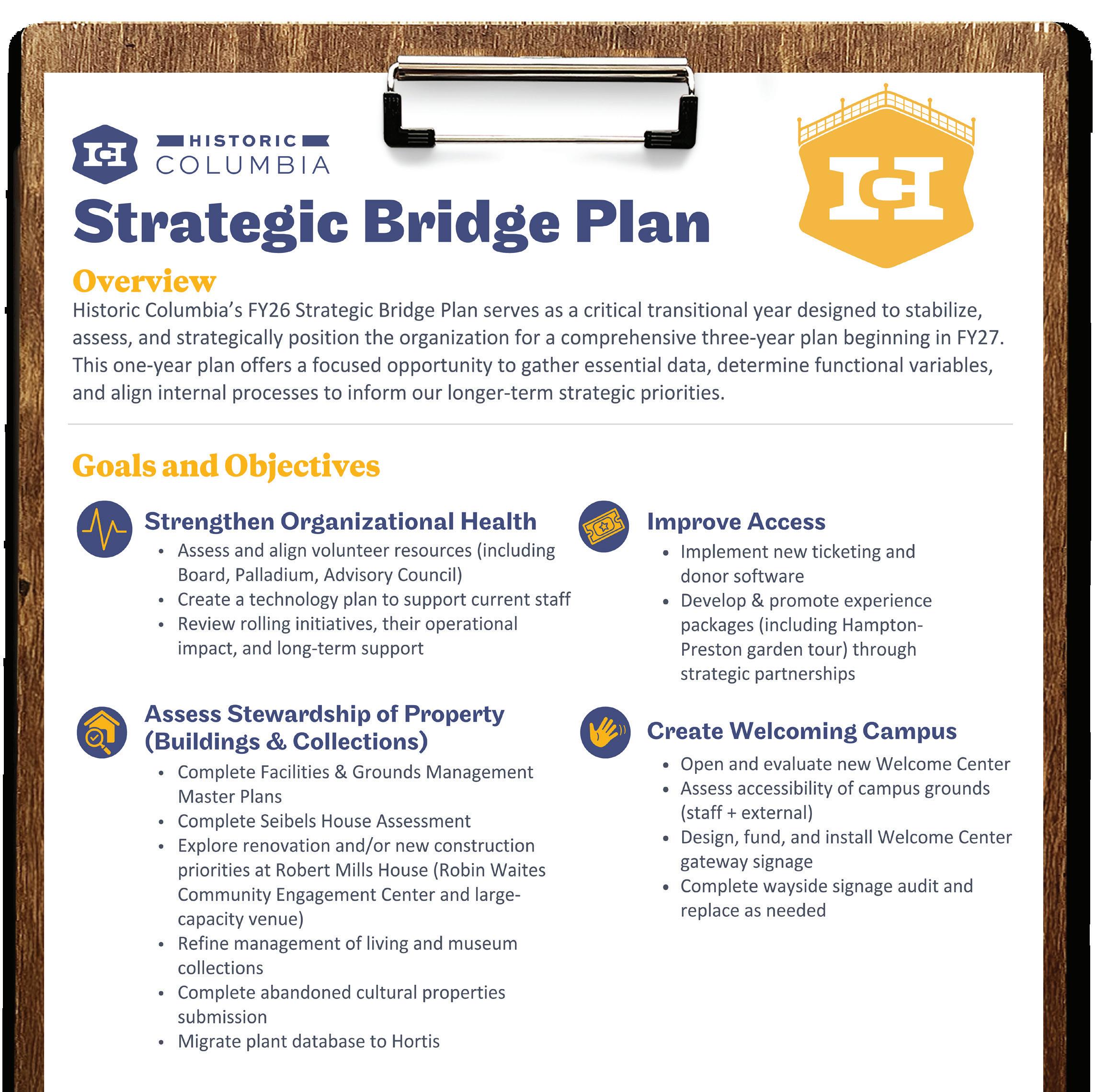
For years, Historic Columbia’s Gift Shop at Robert Mills has greeted visitors with merchandise and a warm smile. But as the way we connect with audiences continues to evolve, so too does the purpose of this important space. At the end of fiscal year 2025, the Gift Shop was reimagined as the Historic Columbia Welcome Center—a true gateway to all that the organization offers. Rather than focusing primarily on retail, the Welcome Center now emphasizes orientation—helping guests discover the depth and breadth of our sites, programs, and stories before stepping foot into a single house museum or garden.
While you’ll still find select merchandise for sale, products are now curated with storytelling in mind. Books, garden-inspired goods, and site-specific souvenirs invite guests to deepen their connection to HC long after their visit.
The Welcome Center has been redesigned to emphasize wayfinding, ticketing, and visitor support. Guests are welcomed with maps, signage, and personal guidance to help them plan their day.
The Welcome Center is becoming a storytelling space itself, with interpretive elements that preview themes visitors will encounter throughout our historic sites and gardens.
“Our goal is to ensure that the Welcome Center is the starting point of every visitor’s journey,” said Visitor Experience Manager Heather Bacon-Rogers. “We want guests to leave with not just a ticket or a map, but with a sense of excitement and clarity about everything they can experience.”
By focusing on orientation and storytelling, the Welcome Center is more than a place to buy a ticket—it’s the launch point for experiencing Columbia’s layered history. This shift underscores Historic Columbia’s commitment to meeting visitors where they are and helping them discover meaningful connections across all of our properties.
As we look ahead, the Welcome Center will continue to evolve, serving not just as a stop along the way but as the beginning of every story we share.

Historic Columbia’s Welcome Center is open: Wednesday – Saturday: 10 a.m. – 4 p.m. Sunday: 1 p.m. – 4 p.m.
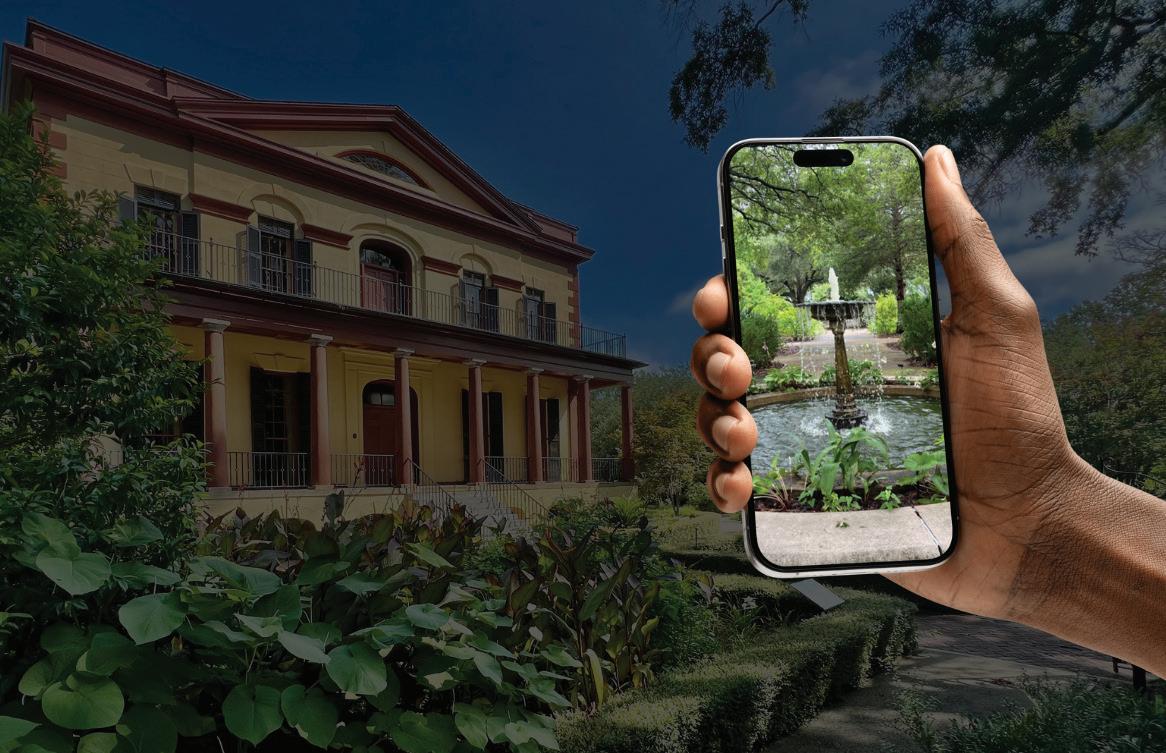
In fiscal year 2025, Historic Columbia took a major step forward in accessibility and innovation by launching our free digital guide on the Bloomberg Connects app. This new resource allows anyone, anywhere, to explore Columbia’s layered history, from stories of architecture and preservation to the lives of the people who shaped our city.
The digital guide features rich multimedia content—including audio narration, archival images, and interactive maps— that bring each story to life. Users can learn about Historic Columbia‘s properties, take a self-paced tour of the Hampton-Preston Gardens, or follow a one-hour, 34-stop tour of the South Carolina State House. Along the way, users will uncover richer stories about Columbia’s history-makers, community advocates, and the everchanging architecture that has defined the city’s character. Joining Bloomberg Connects was an opportunity to share our mission with a broader, global audience. Access the free guide in your browser or in the Bloomberg Connects app today!

Scan the QR code below or to open the guide instantly in your web browser. You can explore Historic Columbia’s content right away—no download required.
2. Download the Bloomberg Connects App
For the full interactive experience, download the free Bloomberg Connects app from the App Store or Google Play. Once installed, open the app and search for “Historic Columbia” to explore our digital guide.
3. Start Exploring
Browse self-guided tours of our historic house museums and gardens, listen to audio stories, and uncover the people and places that shaped Columbia’s past—all from your phone or tablet. Whether you’re on-site or at home, the guide makes it easy to connect with Historic Columbia anywhere, anytime.





Oct. 27: Trunk or Treat 5:30 - 7:00 p.m.
Robert Mills House & Gardens
Grab your costume and join HC for a safe, fun, and FREE Halloween experience. Community members and local organizations throughout Columbia will meet on the grounds of the Robert Mills House to pass out candy to trick-or-treaters! Awards and prizes will be offered for the bestdecorated trunk and table.
Nov. 6: Palladium’s Pints for Preservation
5:30 - 7:30 p.m.
Steel Hands Brewery | Vista
Join Palladium for Pints for Preservation, a happy hour series set in unique, historic venues across Columbia. Enjoy local craft brews, connect with fellow community members, and explore the city’s rich history. Your ticket includes a complimentary beverage and light bites, as well as a brief presentation highlighting the history and preservation of the site.
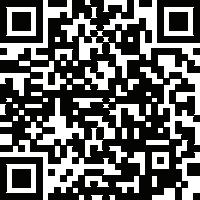


The Bloomberg Connects app is a free digital guide showcasing cultural organizations around the world—making it easy to access and engage with arts and culture from mobile devices, anytime, anywhere. The app allows you to explore over 1,000 collections from botanical gardens, performance venues, outdoor sculpture parks and museums around the world. To be as accessible as possible, the content is avaialble in many languages thanks to integration with Google Translate. It is fully compatible with screen reading devices, and all multimedia content is captioned and transcribed.
Learn more at bloombergconnects.org.


Nov. 12 - Jan 4: Holiday House Tours
Buy tickets online or at the Welcome Center at Robert Mills
The Robert Mills House and the Hampton-Preston Mansion are decorated for the season! Enjoy a holiday tour and learn how families celebrated in the 19th and early 20th centuries. Tours offered every Wednesday-Sunday from Nov. 12-Jan. 4.
Nov. 15: Columbia Conversations
1:00 p.m.
Robert Mills Carriage House
A book talk with Jennifer Whitmer Taylor, author of Rebirth: Creating the Museum of the Reconstruction Era. Discover how Columbia’s former Woodrow Wilson home became a model for interpreting difficult histories, followed by an optional behind-the-scenes tour with Dr. Taylor.
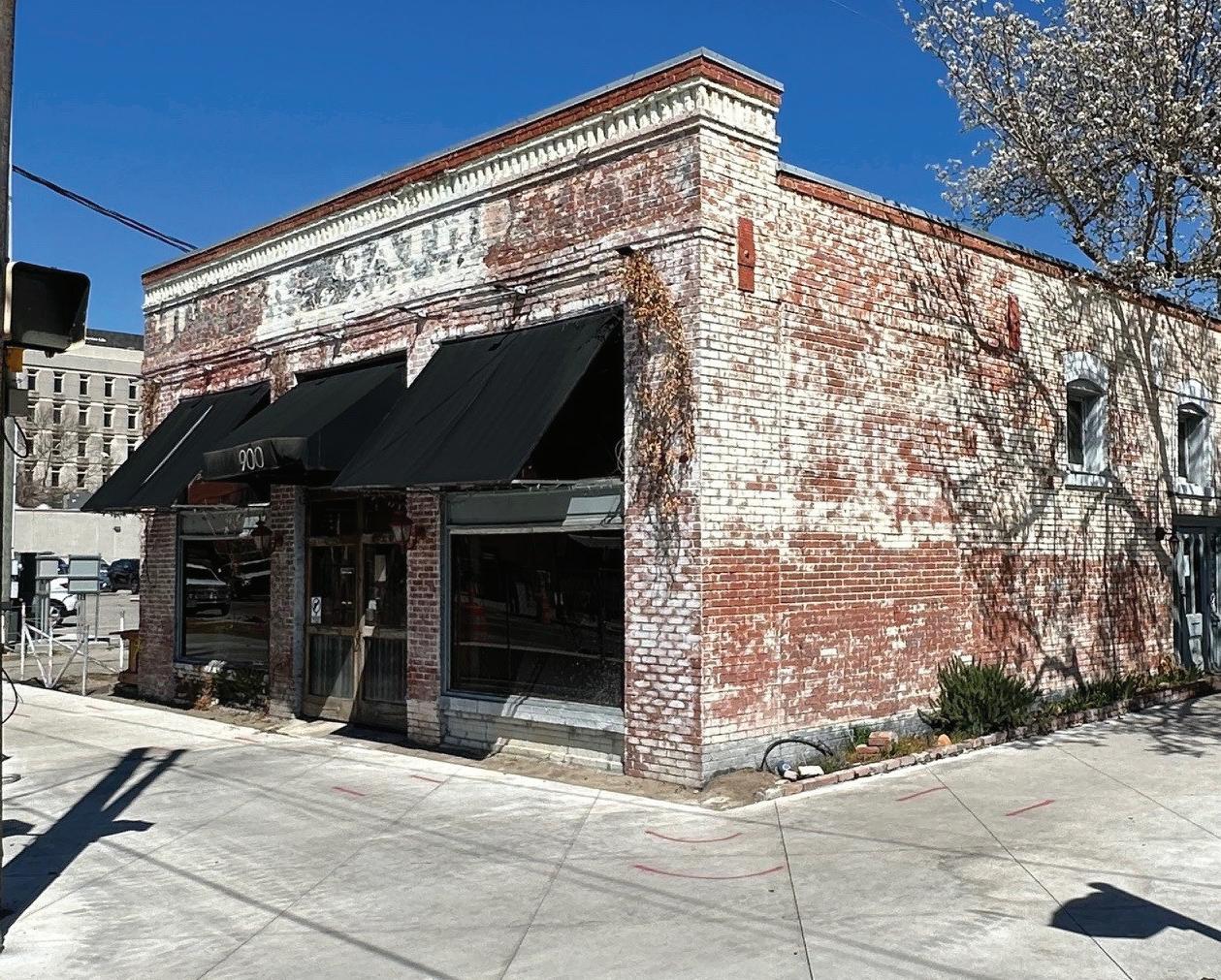
By the early spring of 2025, newly formed partnerships resulted in salvaging 900 Main Street’s building materials during June and July.

or more than a generation, Columbia residents and visitors looking for craft beer and live music found their way to the corner of Main and College streets. Inside a one-story brick building with exposed walls, hand-hewn beams, iron railings, and a mezzanine crafted from reclaimed wood, Hunter-Gatherer Brewery offered both atmosphere and comfort. Since 1995, entrepreneur and brewmaster Kevin Garner welcomed people to enjoy pints and meals in a space that felt both timeless and familiar.
The building at 900 Main Street had a long history before HunterGatherer made it home. Built in 1913 for the E.B. Lyon Motor Car Company, it later became Campus Club South in 1970, a college bar known for its proximity to campus and affordable beer. A series of bars and eateries followed, paving the way for Garner’s microbrewery, which would become a fixture of the city for nearly three decades.
When Hunter-Gatherer closed its doors in December 2024, many assumed the building would continue under new ownership. But without local landmark status or protection as part of a
By JOHN SHERRER D irector of Preservation
historic district, preservation wasn’t guaranteed. Despite Historic Columbia’s appeals to retain the building—or at least its defining elements—the University of South Carolina moved forward with plans to demolish the structure for future campus development.
What seemed destined to be a total loss, however, took a different turn. Alan Todd and Sara Keever of Conway Salvage and Heritage Project, along with their partners at Re:Purpose Savannah, offered an alternative: deconstruction. Rather than sending the building to a landfill, they carefully disassembled it so that valuable materials could live on elsewhere. The structure’s sturdy heart pine, pecky cypress, and early 20th-century brick were salvaged to support the rehabilitation of other historic properties and inspire new construction.
Working alongside Historic Columbia and artist Lauren Andreu—whose mural on the building’s north wall honored friend and musician Aaron Graves—Conway Salvage led a community effort. Volunteers, donated equipment from Blanchard Equipment, storage help from USC Facilities, and support from Amick Equipment all played a role. Over seven
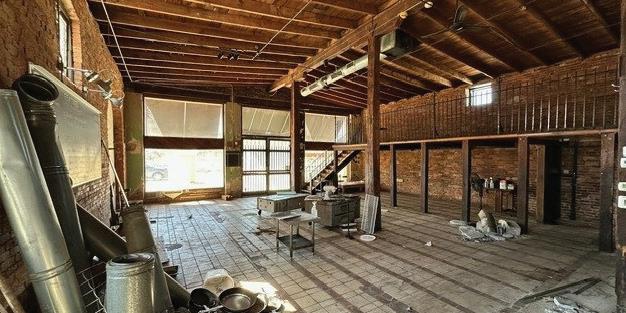
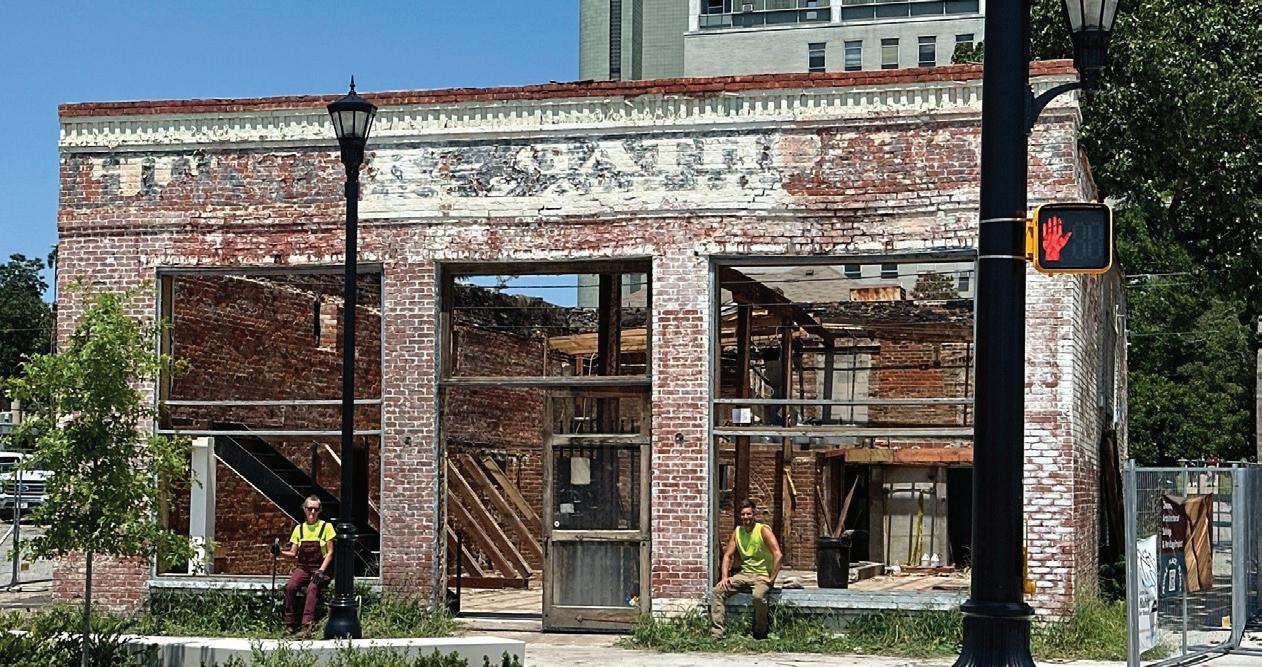
TOP: The interior of the former Hunter-Gatherer featured substantial structural timbers and a mezzanine comprised of previously repurposed two-inch-thick decking.
BOTTOM: With the roof off, the detail of the building’s masonry construction became more apparent.
95%
weeks in the summer of 2025, the project transformed what could have been a wasteful demolition into an opportunity to preserve resources and history. The ribbon above highlights just how much was saved.
The project’s outcome was both practical and symbolic. Though no one celebrated the loss of a historic building, the careful work of deconstruction showed that even in moments of loss, there are ways to create lasting benefits.
If Columbia hopes to avoid similar situations in the future, stronger preservation tools will be essential. Expanding local historic districts, designating landmarks, and raising awareness of how real estate decisions affect our shared history all matter. When we act together, we can protect more of the city’s built heritage—and rely less on salvaging its remains.

team from Re:Purpose
10
a
39 TONS Carbon emissions prevented from brick reuse
Equal to what 1,600+ trees absorb per year
21
prevented from wood reuse Equal to 11 cross-country car trips

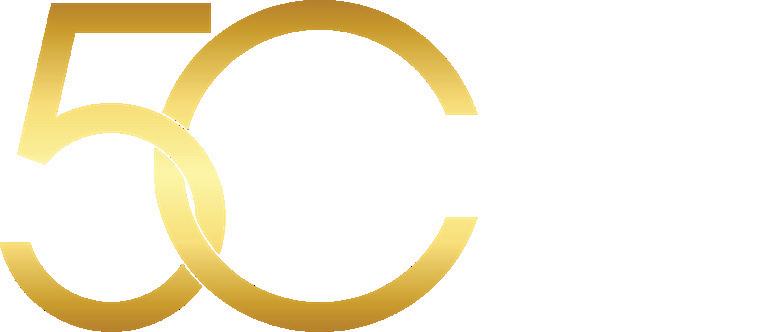

Historic Columbia is thrilled to celebrate the 50th Anniversary of the Preservation Awards–50 Forward. A golden milestone honoring five decades of preservation excellence—and the visionaries who’ve made it possible!
This year’s celebration will be bigger than ever, taking place at Columbia’s newest event space, The Laundry at BullStreet. Full details are coming soon, but for now…mark your calendars for an unforgettable evening of history, innovation, and community spirit!
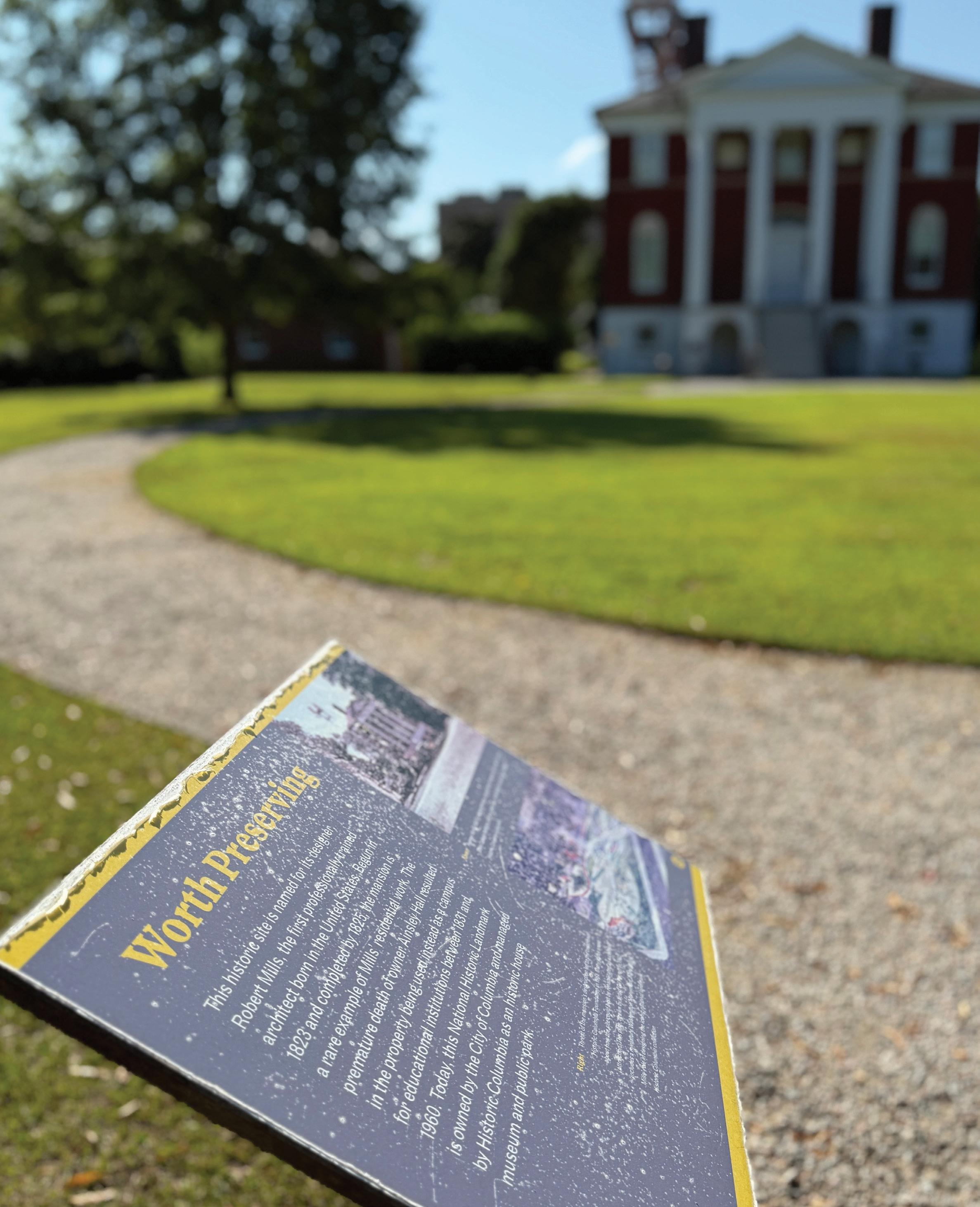
very path, garden, and building across Historic Columbia’s 14 acres tells a story—not just through the architecture, but through the signs that guide, interpret, and invite exploration. From the moment a visitor steps onto our grounds, clear and thoughtful signage ensures they feel oriented, informed, and welcomed.
Thanks to your years of support, these historic sites have become living classrooms—spaces where discovery unfolds at one’s own pace. Yet the elements take their toll, and as our organization grows, so too must our interpretive tools evolve. That’s why this year’s Annual Fund focuses on a Campus Signage Improvement Campaign—a project that ensures every guest, from first-time visitor to lifelong member, can navigate our spaces with ease and engage deeply with the stories they reveal.
Help us raise $25,000 to improve signage across Historic Columbia’s campus. Your gift supports:
n Repair and Replacement–Restore weathered and damaged interpretive panels.
n New Installation–Add signage where none currently exists for better navigation.
n Visitor Experience–Enhance accessibility and storytelling across all six sites.
n By Mail
Use the enclosed envelope to send your Annual Fund gift.
n Online
Scan the QR code to make a secure donation and help us enhance visitor experiences across all six historic sites.

Thank You for Your Support!
Across our six sites, Historic Columbia maintains nearly 200 interpretive and wayfinding signs, all in various conditions. These markers connect past to present, directing guests through historic landscapes and interpreting the layered histories of those who lived and labored here. Supporting this campaign means investing in:
n Wayside Interpretive Signage – New, weatherresistant panels with updated narratives and accessible QR codes for expanded digital content.
n Wayfinding Directional Signage – Refreshed, cohesive markers to guide visitors intuitively through our interconnected campus.
Your gift to the Annual Fund helps Historic Columbia uphold its promise of accessibility, hospitality, and education for all. Together, we can ensure that every visitor—whether a curious student, a seasoned historian, or a family exploring on a sunny afternoon—can experience our sites as they were meant to be: welcoming, informative, and inspiring.
Historic Columbia is a nonprofit organization dedicated to preserving and sharing the stories that shape our community. This year, we invite you—our friends and supporters—to help us enhance how those stories are experienced through a Campus Signage Improvement Campaign. Across our six sites, updated interpretive and wayfinding signage will make our grounds more welcoming, accessible, and informative for all who visit. Your gift to the 2025–26 Annual Fund ensures that every guest can explore our historic spaces with clarity and connection. Gifts of all sizes make a difference—thank you for helping us guide the way to Columbia’s past, present, and future.
historiccolumbia.org/annualfund t
Produced in 1880 by porcelain manufacturer Bates, Gildea & Walker in Stoke-on-Trent, England, this china is an enduring example of Japonisme—an American and European aesthetic that developed following Japan’s debut on the world trade market in 1853.
Part of a twenty-piece set recently donated to Historic Columbia, this tableware was likely utilized in the Grand Central Hotel restaurant on the northeast corner of Plain and Richardson streets (now Hampton and Main, respectively) by the early 1890s. At that time, German immigrant John Seegers (1830–1912) and his son-in-law, Christopher Cord Habenicht (1848–1898), operated the Grand Central Hotel along with a saloon, liquor store, brewery, bottling company, and icehouse in the capital city.
Bates, Gildea & Walker
Tureen & Dinner Plate, 1880 Historic Columbia collection
